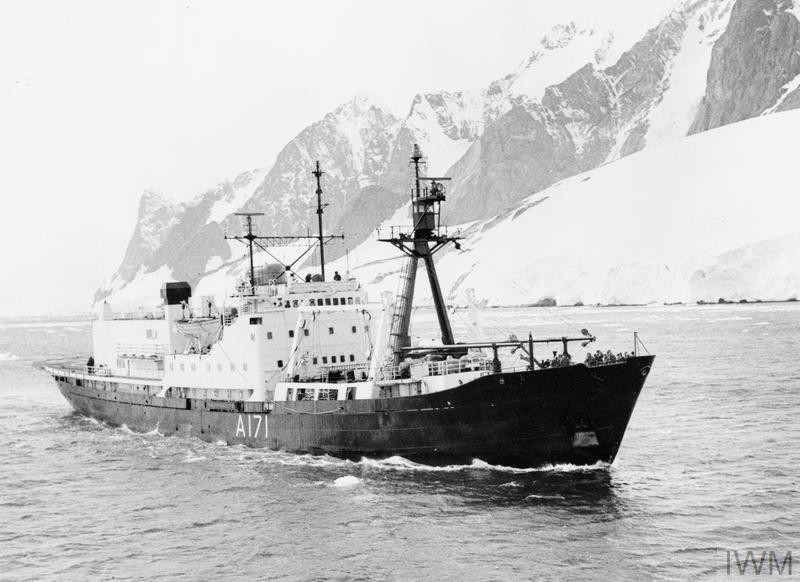40 years ago today the dispute between Argentina and the UK in the South Atlantic erupted into conflict when Argentine launched Operation Rosario, sending troops into the Falkland Islands.
In fact, the initial move had come on 19 March 1982 when a group Argentine scrap metal merchants – a party which included a number of marines – raised their nation’s flag on the island of South Georgia, another British outpost almost 900 miles east of the Falklands in the far south of the Atlantic Ocean.
Argentina’s claim to this remote territory stemmed from its status as part of the Falklands dependency
Ice patrol ship HMS Endurance – which the MOD had planned to decommission in mid-April 1982 – was sent to order the Argentine party to leave; the Argentine group had licences for the work in place, but they had failed to inform the British authorities as required under the terms of the agreement.
Endurance took with her a small group of Royal Marines who had been stationed in the Falklands.
As tensions rose, Argentine icebreaker ARA Bahia Paraiso landed around 100 marines to ‘protect’ their compatriots; the much smaller party of Royal Marines were told to monitor Argentine activity at the old whaling station of Leith.
Meanwhile, British personnel familiar with the situation in the South Atlantic were sending urgent warnings back to the UK that they believed that an invasion of the Falklands was imminent.
Those warnings were heeded; the British government sent a telegram to Falklands Governor Rex Hunt on 1 April, predicting an invasion the following day – an event they believed had been brought forward because of the developments in South Georgia.
Operation Rosario was actually put into effect late on the evening of 1 April when Argentine special forces went ashore south of Stanley, the capital of the Falklands, while commandos from submarine ARA Santa Fe marked out the chosen landing beach.
The main invasion force disembarked from tank landing ship ARA Cabo San Antonio on Friday 2 April, by which time a defensive strategy was being implemented by Rex Hunt and Maj Mike Norman, who was in overall command of the Royal Marines contingent on the islands – Naval Party 8901, numbering a few dozen men.
This group was actually much larger in number than was normally the case as the invasion happened just as the personnel were handing over to those who had arrived to relieve them.
The Royals were supported by a couple of dozen members of the volunteer Falkland Islands Defence Force, tasked with defending strategic locations such as the islands’ radio station and telephone exchange, although it was recognised that such defence would be largely symbolic in the face of a large-scale Argentine invasion.
Argentine marines who went ashore ahead of the main invasion force were planning to capture Royal Marines they expected to find at Moody Brook barracks, but the buildings were empty.
Maj Norman, who had been alerted to the enemy’s presence, drove to Government House and ordered British troops to join him – parties of Royal Marines had formed outer defences, including points along the main Airport Road. Falklands volunteers were sent to their drill hall and ordered to put up no resistance.
Some 20 Argentine armoured personnel carriers landed at Yorke Bay from the Cabo San Antonio, part of a sizeable invasion fleet, around 6 am and headed into Stanley, but were attacked by Royal Marines, who damaged at least one of the vehicles.
Troops also went ashore by helicopter and from at least two landing craft.
Sections of Royal Marines used all their courage, fitness and ingenuity to run, crawl and slip back from their forward positions to Government House, which had been under attack for an hour or more by this point.
A hastily-arranged ceasefire came into effect just before 9am, when Rex Hunt began negotiating a surrender to avoid heavy loss of life, although the Royal Marines were in no mood to give up the struggle, and had been willing to either lay down their lives to defend the territory or attempt a break-out in order to set up a new HQ out in the wilds of the islands (referred to locally as ‘Camp’) and continue the fight from there.
But the decision was made that the defenders should lay down their arms (the word ‘surrender’ was not used) around 9.30am, with no casualties and having won the admiration of Argentine commanders for their brave and determined stand. Wounded Argentine troops were taken to Stanley Hospital to be patched up.
The British Royal Marines and a small group of sailors from HMS Endurance, along with Rex Hunt (wearing full ceremonial regalia in a small act of defiance) and his wife Mavis were flown to Uruguay via Argentina and on the UK on an RAF VC-10 jet; the party was welcomed as heroes on arrival at RAF Brize Norton.
With the islands in their possession, the Argentine junta, led by Gen Leopoldo Galtieri, believed they had achieved their objective – but bold plans were already being laid to regain the Falklands in what would come to be known as Operation Corporate.
n These posts can only give a brief sense of what was a complex and fast-moving situation 40 years ago – for a much more detailed account see naval-history.net at https://www.naval-history.net/NAVAL1982FALKLANDS.htm
Our image today, from the Imperial War Museum collection (© IWM MH 27511), shows Royal Navy ice patrol ship HMS Endurance off South Georgia
